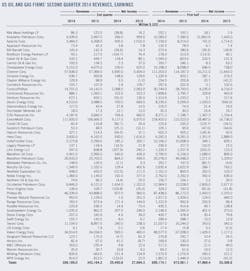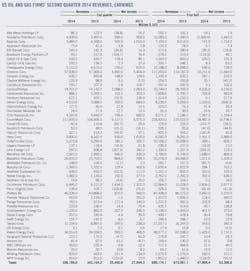Conglin Xu
Senior Editor-Economics
Laura Bell
Statistics Editor
Second-quarter profits for a group of 53 US-based producers and refiners totaled $25.45 billion, which was down 8.1% from the same period in 2013. Thirty-two of the group had lower earnings than they booked in the same period last year, and 14 companies recorded a loss.
The group's profits for the first half dipped to $47.97 billion or 10% below those from first-half 2013. Thirty-one companies posted a decline and 11 companies posted a loss in the first half.
Positive drivers, including stronger crude oil and natural gas realizations, production increases in North America, and asset gains, were more than offset by impacts of divestment, impairment charges, losses on commodities derivatives, and increased expenses.
Midwest and East Coast refiners also faced lower cash margins compared with the year-earlier quarter.
Meanwhile, a sample of oil and gas producers and pipeline companies with headquarters in Canada posted a strong combined increase in net income and revenues for the recent quarter compared with second-quarter 2013. The sample benefitted from higher commodity prices and increased production volumes.
Market trends
Oil prices rose during the second quarter. Spot prices of West Texas Intermediate crude, the US benchmark, increased $4 from the first quarter to average $103.35/bbl. This is $9.25 higher than last year. Brent, the global benchmark, increased slightly to $109.70/bbl, up $7 from last year.
The differential between WTI and Brent narrowed further during the quarter, averaging $6/bbl, a $3 decline from the average in the first quarter.
ICE Brent crude oil front-month futures averaged $109.57/bbl during this year's second quarter, up $6.10 from a year ago. Front-month crude futures on the New York Mercantile Exchange in the second quarter averaged $102.99/bbl compared with $94.17/bbl during the same quarter last.
US liquid fuels demand decreased slightly during the second quarter from the first 3 months, averaging 18.71 million b/d. This is slightly above the average consumption during last year's second quarter.
Drilling activity remains strong in the US during the quarter. The number of active rigs reached 1,861 for the month of June, up from 1,761 a year earlier, according to Baker Hughes Inc. Rigs drilling for oil climbed to a historic high of 1,545 at the end of the second quarter, while the number of gas rigs shrank to 314. The rig count for onshore operations increased 6% to 1,804 in June from a year earlier. Those rigs drilling offshore were up slightly, to 57, compared with 55 in June 2013.
US domestic production of crude oil averaged 8.4 million b/d in the second quarter, up 1.1 million b/d from last year. Texas and North Dakota continue to see big increases in crude oil production.
Natural gas prices declined in the second quarter following a dramatic increase in the first quarter. Prices averaged $4.60/MMbtu in the second quarter, down from $5.20 in the first quarter but still 60¢ higher than second-quarter 2013.
Front-month NYMEX gas futures averaged $4.58/MMbtu for the second quarter vs. $4.02/MMbtu a year earlier.
Natural gas inventories increased over the second quarter but remained significantly lower than at this time last year.
US cash margins for the quarter ended June 30 averaged $18.59/bbl for the Midwest, $17.75/bbl for the West Coast, $9.68/bbl for the Gulf Coast, and $2.43/bbl for the East Coast. In second-quarter 2013, the average cash refining margins for these refining centers averaged $26.62/bbl, $15.87/bbl, $7.17/bbl, and $3.43/bbl, respectively. The average cash refining margins in northwestern Europe and Southeast Asia during the quarter were $1.39/bbl and 87¢/bbl, down from respective averages of $3.77/bbl and $1.96/bbl a year earlier.
The average composite cost of crude oil for US refiners in this year's second quarter was $100.94/bbl, up from $99.44/bbl a year earlier, according to the US Energy Information Administration.
US producers
ExxonMobil Corp. recorded earnings of $9.1 billion for this year's second quarter compared with $6.9 million for second-quarter 2013. This reflects strong operations and asset divestment.
The company's oil-equivalent production decreased 5.7% from the second quarter of 2013, largely due to the Abu Dhabi onshore concession expiry, while higher realizations and asset management helped to increase upstream earnings by 25% from a year earlier. Non-US operations contributed to the majority of second-quarter upstream earning growth.
The company's downstream earnings were $711 million, up $315 million from second-quarter 2013. Negative impacts of weaker refining margins were more than offset by higher volumes and sales, asset management effect, and lower operating expenses.
Chevron Corp. reported earnings of $5.7 billion for the second quarter compared with $5.4 billion in second-quarter 2013. This reflects stronger market conditions for crude oil and gains on asset sales, which were partly offset by lower production volumes as a result of planned maintenance activity in Kazakhstan as well as negative foreign currency effects. The company's worldwide net production was 2.55 million boe/d in this year's second quarter, down from 2.58 million boe/d in second-quarter 2013. The company's average sale prices of crude oil, natural gas, and natural gas liquids all climbed in the second quarter compared with second-quarter 2013.
Higher earnings from the 50%-owned Chevron Phillips Chemical Co. LLC, stronger margins on refined product sales, and higher gains from asset sales contributed to an increase of $379 million in Chevron's second-quarter US downstream earnings. However, the company's international downstream earnings decreased $424 million from last year's second quarter, primarily due to lower refined product sales margins, unfavorable derivative instrument, and foreign currency effects.
ConocoPhillips posted second-quarter earnings of $2.1 billion compared with second-quarter 2013 earnings of $2.06 billion. Adjusted earnings excluding special items, however, increased to $2 billion from $1.8 billion a year earlier, reflecting higher realized prices and volumes, partly offset by higher depreciation and operating costs associated with new production as well as higher corporate expenses.
The company's production from continuing operations, excluding Libya, averaged 1.55 million boe/d for the quarter, a 6% increase compared with the same period in 2013. The company's combined production from Eagle Ford and Bakken play areas increased 38% from second-quarter 2013.
Apache Corp. reported second-quarter earnings of $505 million, excluding certain items that impact the comparability of results. For the same period in the prior year, Apache's earnings were $1 billion. The decrease in earnings reflects impacts from properties that have been divested, including producing assets in the Gulf of Mexico, Canada, Argentina and noncontrolling interest in Egypt.
Compared with the same period a year ago, Apache's onshore North American liquids production increased 18% on a pro forma basis in this year's second quarter to more than 201,000 b/d. The company intends to broaden and advance its North American onshore liquids portfolio by completing the sale of nonproducing Lucius and Heidelberg deepwater developments and divesting selected, primarily gas-producing properties in western Canada and South Texas. In addition, Apache also intends to completely exit the Wheatstone and Kitimat LNG projects to focus on North American onshore liquids growth.
Hess Corp. announced net income of $930 million in this year's second quarter compared with second-quarter 2013 earnings of $1.6 billion, primarily reflecting impacts of divesting upstream assets and downstream businesses.
Anadarko Petroleum Corp. reported net income of $266 million for this year's second quarter. During the quarter, Anadarko's sales volumes of crude oil, natural gas, and natural gas liquids averaged 848,000 boe/d, which represented a 13% increase over second-quarter 2013.
Refiners
HollyFrontier Corp. posted second-quarter net income of $185.2 million, down from $265.7 million for the same quarter a year ago, primarily due to lower second-quarter refining margins. Refinery gross margins were $14.54/bbl, a 28% decrease from second-quarter 2013. For the first 6 months of this year, HollyFrontier's net income was $349 million compared with $609 million for first-half 2013.
Valero Energy Corp. reported net income of 593 million for this year's second quarter compared with $465 million for second-quarter 2013. The company's operating income in the most recent quarter climbed $280 million from the same quarter a year earlier, due primarily to higher refining throughput volumes and wider discounts relative to Brent crude oil for sour and certain North American light crude oil. These positive drivers were partly offset by weaker gasoline and distillate margins relative to Brent crude oil in most regions and higher natural gas costs.
Tesoro Corp.'s earnings were virtually flat in this year's second quarter from last year, standing at $240 million b/d. The Tesoro Index was $13/bbl for the quarter, down from $15/bbl last year. The addition of the Los Angeles refinery and the capture of synergies offset the lower margin environment in the quarter, leading to a higher overall capture of the Tesoro Index. The overall gross margin for the quarter was 103% of the Tesoro Index compared with 98% of the Tesoro Index last year.
Marathon Petroleum Corp. reported second-quarter earnings of $864 million compared with second-quarter 2013 earnings of $599 million. Refining and marketing operations income was $1.26 billion in the most recent quarter compared with $903 million in second-quarter 2013. The increase was primarily due to more favorable net product price realizations and a higher US Gulf Coast crack spread, partially offset by a narrower WTI to Light Louisiana Sweet crude oil differential and a lower Chicago crack spread.
Canadian firms
All financial figures in this section are presented in Canadian dollars unless noted otherwise.
Suncor Energy Inc.'s net earnings were $211 million for this year's second quarter, down from $680 million for second-quarter 2013. Net earnings for the quarter were negatively impacted by a couple of aftertax impairment charges.
Suncor's portfolio comprised nearly 100% crude-oil weighted production in this year's second quarter compared with 91% in the prior year quarter. The company's total upstream production was 518,400 boe/d, up from 500,100 boe/d in the prior year quarter, reflecting higher production volumes in oil sands.
Canadian Natural Resources posted a record $1.1 billion, compared with net earnings of $476 million in second-quarter 2013. The company's total crude oil and NGLs production achieved a record of 545,200 b/d in this year's second quarter, a 12% increase from second-quarter 2013.
Talisman Energy Inc. recorded a net loss of $253 million during the most recent quarter, primarily driven by an aftertax impairment and movements relating to cash settlements and noncash mark-to-market loss on commodity derivatives. On a year-over-year basis, the company has grown total production from ongoing operations in its core regions by 12% and liquids production by 20%.
Imperial Oil's second-quarter earnings were $1.2 billion, up from $327 million for the same period last year. Included in the quarter was a $478 million gain associated with the sale of interests in several conventional upstream producing assets. Earnings also were higher because of a weaker Canadian dollar and higher bitumen realizations.
Cenovus Energy Inc.'s net earnings for the quarter were $615 million, more than three times higher than the same period a year earlier, benefiting from increase oil production and higher commodity prices. The company's oil sands production averaged nearly 125,000 b/d net in the second quarter, up 33% from a year earlier, primarily driven by strong performance at the company's Christina Lake project.




